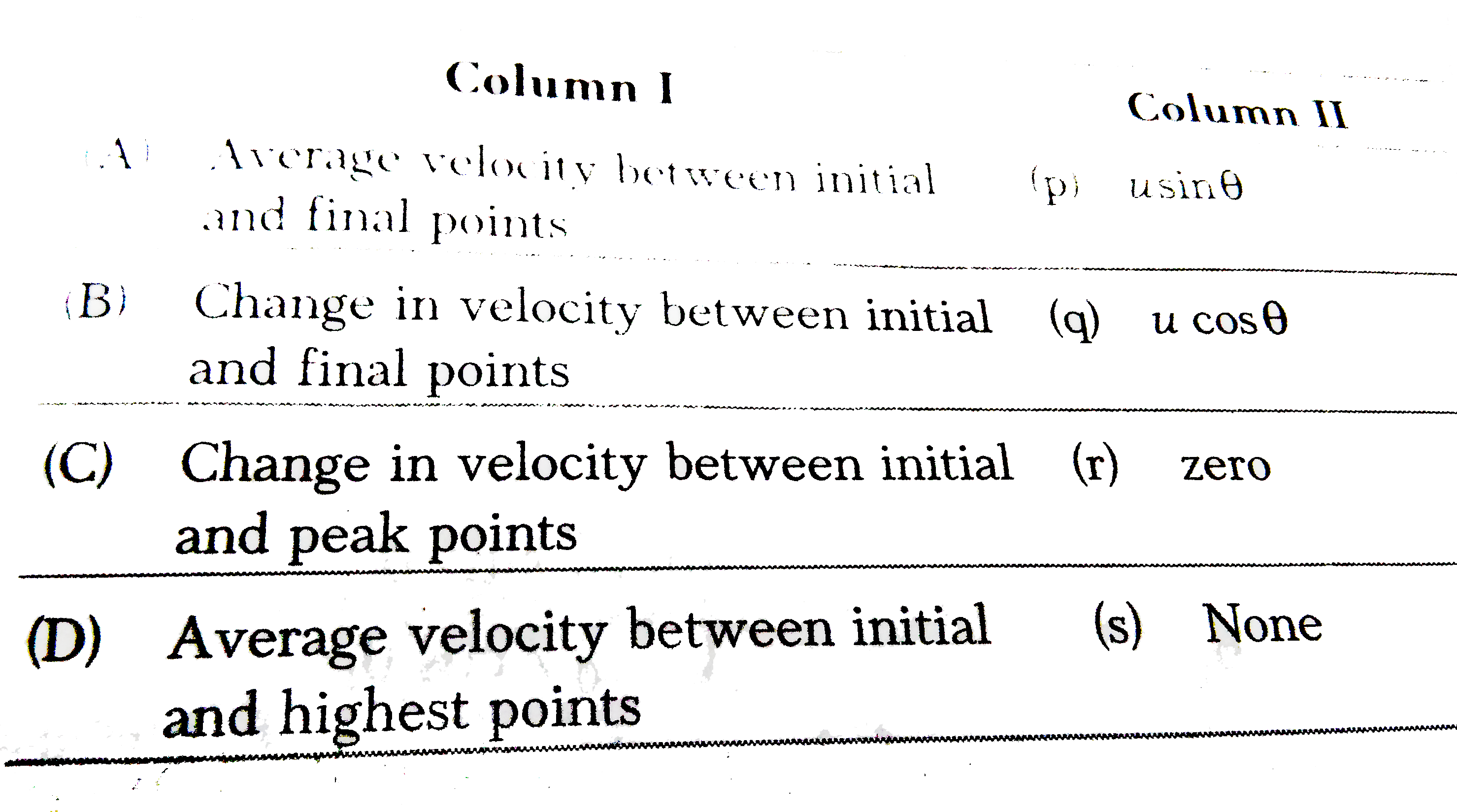A particle is projected from the ground with velocity u making an angle θ with the horizontal. At half of its maximum heights,
its horizontal velocity is ucosθ
its vertical velocity is usinθ√2
its velocity is (1+Cos2θ2)12
all the above are true
The correct Answer is:D
To solve the problem, we need to find the velocity of a particle at half of its maximum height when it is projected from the ground with an initial velocity u at an angle θ with the horizontal.
1. Determine Maximum Height:
The maximum height H reached by the projectile can be calculated using the formula:
H=u2sin2θ2g
2. Calculate Half of Maximum Height:
Half of the maximum height h is:
h=H2=u2sin2θ4g
3. Find Vertical Velocity at Half Maximum Height:
The vertical component of the velocity vy at half of the maximum height can be found using the kinematic equation:
v2y=u2sin2θ−2gh
Substituting h:
v2y=u2sin2θ−2g(u2sin2θ4g)
Simplifying this gives:
v2y=u2sin2θ−u2sin2θ2=u2sin2θ2
Therefore, the vertical component of the velocity is:
vy=usinθ√2
4. Calculate Horizontal Velocity:
The horizontal component of the velocity vx remains constant throughout the motion and is given by:
vx=ucosθ
5. Find the Resultant Velocity:
The resultant velocity v at half of the maximum height can be calculated using the Pythagorean theorem:
v=√v2x+v2y
Substituting the values of vx and vy:
v=
⎷(ucosθ)2+(usinθ√2)2
This simplifies to:
v=√u2cos2θ+u2sin2θ2=u√cos2θ+sin2θ2
6. Final Simplification:
We can express this as:
v=u√2cos2θ+sin2θ2=u√1+cos2θ2
Final Answer:
Thus, the velocity of the particle at half of its maximum height is:
v=u√1+cos2θ2
The maximum height H reached by the projectile can be calculated using the formula:
H=u2sin2θ2g
Half of the maximum height h is:
h=H2=u2sin2θ4g
The vertical component of the velocity vy at half of the maximum height can be found using the kinematic equation:
v2y=u2sin2θ−2gh
Substituting h:
v2y=u2sin2θ−2g(u2sin2θ4g)
Simplifying this gives:
v2y=u2sin2θ−u2sin2θ2=u2sin2θ2
Therefore, the vertical component of the velocity is:
vy=usinθ√2
The horizontal component of the velocity vx remains constant throughout the motion and is given by:
vx=ucosθ
The resultant velocity v at half of the maximum height can be calculated using the Pythagorean theorem:
v=√v2x+v2y
Substituting the values of vx and vy:
v=
⎷(ucosθ)2+(usinθ√2)2
This simplifies to:
v=√u2cos2θ+u2sin2θ2=u√cos2θ+sin2θ2
We can express this as:
v=u√2cos2θ+sin2θ2=u√1+cos2θ2
Thus, the velocity of the particle at half of its maximum height is:
v=u√1+cos2θ2
Topper's Solved these Questions
- MOTION IN A PLANEBOOK - AAKASH SERIESCHAPTER - MOTION IN A PLANEEXERCISE - EXERCISE-3 (Circular Motion)
7 Videos
- MOTION IN A PLANEBOOK - AAKASH SERIESCHAPTER - MOTION IN A PLANEEXERCISE - EXERCISE-3 (A boat in a river)
3 Videos
- MAGNETISMBOOK - AAKASH SERIESCHAPTER - MAGNETISMEXERCISE - ADDITIONAL EXERCISE
22 Videos
- MOTION IN A PLANEBOOK - AAKASH SERIESCHAPTER - MOTION IN A PLANEEXERCISE - QUESTION FOR DESCRIPTIVE ANSWER
7 Videos
Similar Questions
A particle is fired from a point on the ground with speed u making an angle θ with the horizontal.Then
View SolutionA particle is projected from the ground with velocity u at angle θ with horizontal. The horizontal range, maximum height and time of flight are R,H and T respectively. They are given by, R=u2sin2θg,H=u2sin2θ2g and T=2usinθg Now keeping u as fixed, θ is varied from 30∘ to 60∘. Then,
View SolutionA particle is projected from ground with speed u and at an angle θ with horizontal. If at maximum height from ground, the speed of particle is 1/2 times of its initial velocity of projection, then find its maximum height attained.
View SolutionA body is projected from ground with velocity u making an angle θ with horizontal. Horizontal range of body is four time to maximum height attained by body. Find out
(i) angle of projection
(ii) Range and maximum height in terms of u
(iii) ratio of kinetic energy to potential energy of body at maximum height
View SolutionA particle is projected with a velocity u making an angle θ with the horizontal. At any instant its velocity becomes v which is perpendicular to the initial velocity u. Then v is
View SolutionA particle is projected from a point O with velocity u in a direction making an angle α upward with the horizontal. AT P , it is moving at right angles to its initial direction of projection . Its velocity at P is .
View SolutionSTATEMENT-1: A body is projected from the ground with a velocity v at an angle with the horizontal direction, it reaches a maximum height (H) and reaches the ground after a time T = 2u sin θ/g
STATEMENT-2: The vertical and horizontal motions can be treated independently
View SolutionA particle is projected from a point P with a velocity v at an angle θ with horizontal. At a certain point Q it moves at right angles to its initial direction. Then
View SolutionA particle is projected from a point P with a velocity v at an angle θ with horizontal. At a certain point Q it moves at right angles to its initial direction. Then
View SolutionA particle is projected form ground with velocity u ar angle θ from horizontal. Match the following two columns.

View Solution
